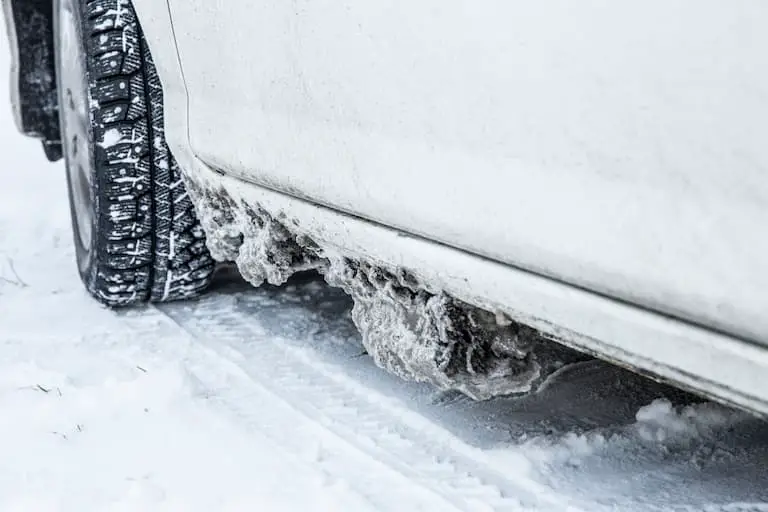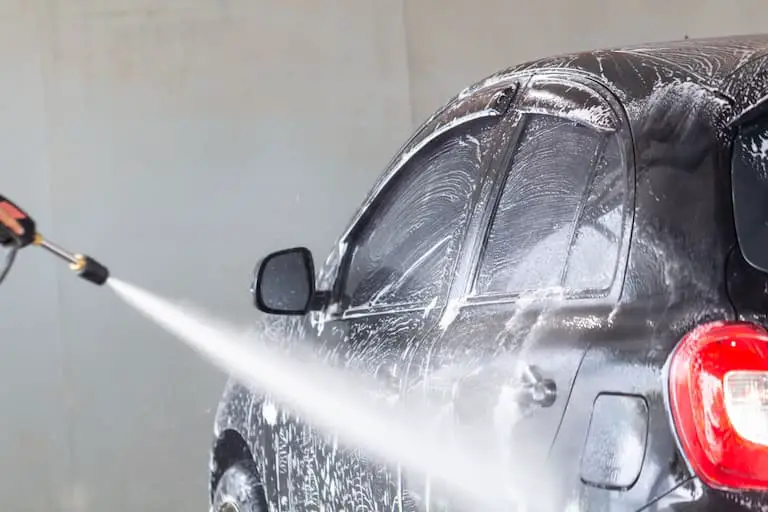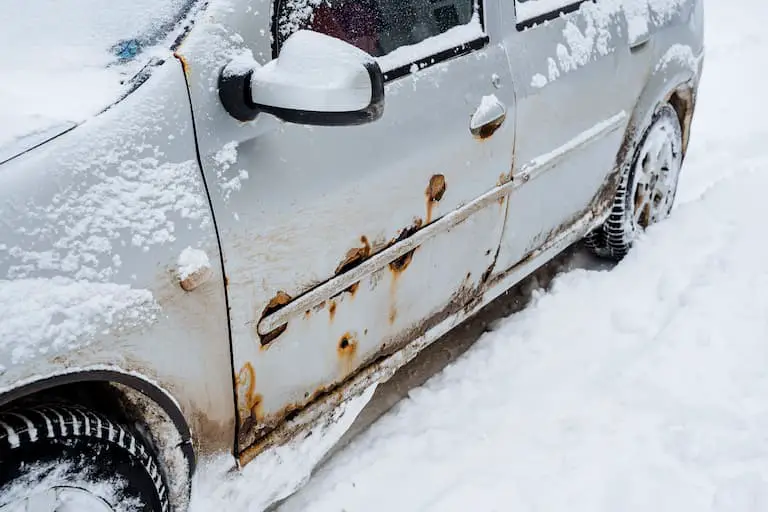As an Amazon Associate, we earn from qualifying purchases. We may also earn commissions if you purchase products from other retailers after clicking on a link from our site.
If you live in areas that receive heavy snow, road salt is a double-edged sword. It makes driving in the snow safer, but if left on a car’s exterior, it can cause serious damage. And since washing a car in cold weather can be a challenge, how long should you wait before you wash the car?
How long you can leave salt on your car depends on several factors. These include the age of your vehicle, how much snow your area receives, and whether your county uses rock salt or brine. In general, you should aim to wash your vehicle once a week.
Keep reading for tips on how to get salt from your car and preventative measures. And since many municipalities and counties are switching to a brine solution, you’ll learn why it’s more important to remove brine as soon as possible.

How Often You Should Wash the Rock Salt From Your Car
Most sites suggest that you should wash a car every two weeks, but in the winter, aim for once a week. Some sites, like the New York Times, suggest you wash it as soon as possible, although that advice ignores that the slushy water left after the snow melts contain salt.
Where and what you wash is as important as how often you wash your car. For example, a simple hosing down of your car will not remove salt from the areas that really need salt removal.
Here are some tips on ways to remove salt from your vehicle:
- Plan for weekly washes. If you can, plan for weekly washes, and if possible, wash the car as soon as practical after a snowstorm to remove the salt.
- Clean the undercarriage. Simply washing the top and sides of your car will not be enough, as you’ll also need to clean the undercarriage. Choose a car wash that sprays under your vehicle.
- Don’t drive behind a plow truck. Following a plow means you’ll be the first to go through a fresh layer of salt. Also, try to avoid puddles, which contain more salt than the road.
- Avoid car washes that recycle water. Many car washes use “repurposed” or recycled water, which will contain higher salt levels. Instead, use car washes that don’t recycle water or go to a self-serve car wash.
- Use high-pressure hoses. Make sure the carwash has hoses that have enough pressure to blast the salt off the hard-to-reach wheel wells. And even if the ground is cold, you’ll leave salt behind unless you scrub the wheel wells and wheels.
- Dry your car thoroughly. Ice is a magnet for salt, so try to clean your car when the temperature reaches 40℉ (5℃), or above. Use a hairdryer if the temperature is colder. And if possible, daytime cleaning is better than in the evening.
Bottom line, if you can wash your car once a week, you’ll be able to keep your vehicle in good shape and keep salt from damaging your car.

What Area of a Car Is Impacted the Most?
The area of a car that is impacted the most by road salt is the undercarriage. Since it is fully exposed to the road, it is more vulnerable to road salt damage than other areas of your car.
The fuel lines and hydraulic brake system are particularly vulnerable to rust. In addition, the muffler, coil springs, and subframe are also susceptible to rust. Therefore, to get complete protection for your car, you need to prevent damage to the undercarriage.
What Can I Do To Protect My Car From Salt?
To protect your car from salt, take preventative measures. Unfortunately, rust never entirely goes away once it starts to form. That’s why the best “cure” is prevention. After all, even though we make plans to wash on a regular schedule, life sometimes throws a wrench in those plans.
Here are some further tips to protect your car from salt:
- Undercoat your car: This advice is commonly given, but there is debate about its importance. Consumer Reports, for example, suggests it is not necessary for new cars. People often balk at the price, but often small shops can do it for less than a dealership. Of course, DIY is another option, but it is a complicated route to take.
- Wax your car: Before winter, wax your car. Even though your car’s undercarriage has the greatest risk for damage, waxing your car helps keep ice and snow from sticking to your vehicle.
- Clean your tires: Make sure your tires are clean before winter arrives, then keep them clean during the winter months. Dirty tires are more likely to spray rock salt on your car.
How Brine Affects Cars
Brine is a salt-water combination that is poured on the road, but it can cause even more damage because it sticks to the road better than salt crystals.

Also, brine containing magnesium chloride is even more likely to damage your car.
So even though brine can do more damage to cars, it is used because when the salt crystals dissolve in water, they remain on the road longer.
When rock salt is poured on the street, some of it bounces and rolls onto sidewalks, ditches, and driveways. That rock salt is now useless. But because brine is a solution, it doesn’t bounce like plain rock salt.
Magnesium chloride is commonly used to make brine because it does a better job of melting ice at low temperatures. However, magnesium also removes more moisture out of the air, so in the winter, when humidity levels are lower, magnesium chloride takes moisture out of the air to create a more corrosive crust.
And since it is a liquid solution, brine can get into places in your car’s underside that rock salt cannot. So if your county uses brine to melt snow, you need to be more vigilant and clean your vehicle more frequently.
Bottom Line
Keeping rock salt and brine from your car begins with prevention followed by weekly cleaning. Although that might seem like lots of work, the alternative is damage from rust. Not only can rust be unsightly, but if it forms in the wrong place, your car’s brakes or fuel lines could also be damaged. That’s not unsightly but dangerous.
